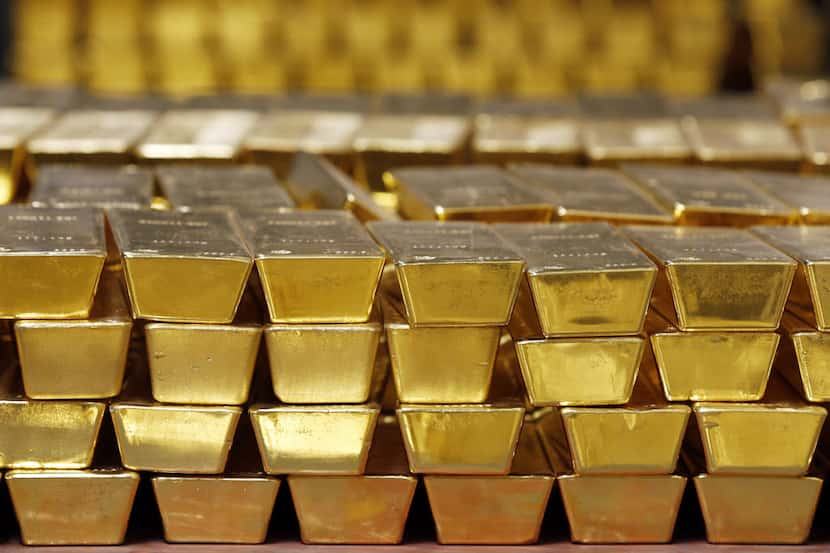Following what officials described as a complicated, two-year long development process, Texas is about to become the first state in the union to have its very own gold bullion depository.
Austin-based Lone Star Tangible Assets, a company that moves and stores gold and other precious metals, was chosen from among six companies for a five-year contract with two one-year extension options, Texas Comptroller Glenn Hegar's office announced Wednesday.
The company is slated to start taking deposits into its existing Austin vaults starting early next year. It has plans to build a new facility specifically for the state.
The move comes as investors, on the advice of TV and radio pundits, buy up gold as a way of protecting themselves against the volatility of the stock market or other types of investments. And, online trading has made it easier for the average person to buy and sell precious metals.
Since the early 2000s, gold prices have increased almost fivefold, from about $270 an ounce to roughly $1,250, according to Bloomberg data.
But before you start picturing a Scrooge McDuck-style swimming pool full of coins tucked away in Austin somewhere, here's what you should know about how the Texas Bullion Depository will actually work:
So how much are taxpayers paying for this?
Well, they’re not really, officials said.
Gov. Greg Abbott signed a bill in 2015 tasking the comptroller's office with establishing the nation's first ever state-administered bullion depository. But the Legislature didn't appropriate any extra money for it.
So, after working out the kinks last year, Hegar's office requested proposals from contractors to operate a fully insured gold depository.
Lone Star Tangible Assets already runs a couple of websites that allow people to buy and sell gold. They also already have vault space in Austin that meets high security specifications, Hegar said, so the Texas Bullion Depository should be able to start taking deposits in January.
The company is looking for another site in the “greater Austin area” to build a separate depository and vault that’s expected to open in December 2018.
The timing works out, LSTA’s chairman, Matthew Ferris, said in prepared statements, because "this was an investment we were already planning to make.” He wouldn’t say how much it plans to spend on the new facility.
The state and the company will share revenue, said Tom Smelker, the state’s director of Treasury Operations and the depository’s new administrator. So, the state could make money if enough people pay fees to store their precious metals at the depository. But most of it would likely go back into running the depository, like hiring extra administrative staff.
But the company, he said, is taking on the business risk.
What exactly is a bullion depository, anyway? And what will it look like?
Basically, Smelker said, it’s a “safe and secure vault facility where citizens and businesses can safely store metal assets.”
Most are privately run by big banks that have clients with a lot of assets — only a small portion of which are in gold. And most of those are in and around New York.
Smelker said the Texas depository will be able to accept several precious metals, including gold silver, platinum, rhodium and palladium.
While he couldn’t say exactly how the Texas depository vault will be structured, he said in his research he was surprised by how little space millions of dollars’ worth of gold actually takes up.
“It’s expensive to build and operate vaults,” he said, so silver, which is less valuable by weight, “is often not in the vault, strangely enough.”
He’d seen vault designs where the pallets of silver are stacked high surrounding a gold vault because it’s an additional heavy, physical layer between would-be thieves and gold.
LSTA said it plans to find a 35,000- to 75,000-square-foot site for its new depository.
Who decided Texas needed its own, state-run facility to keep gold? And why?
At the time, Abbott said the aim of the legislation creating the depository was to “repatriate $1 billion of gold bullion from the Federal Reserve in New York to Texas.”
But the state itself holds almost no gold. The Texas Tribune reported that $1 billion figure referred to the University of Texas Investment Management Co.'s gold bullion holdings — now at $861.4 million — which are currently at HSBC Bank in New York.
UTIMCO is a nonprofit corporation that manages the assets of the UT system, and the gold is only a part of a much larger portfolio.
Jenny LaCoste-Caputo, a UT spokeswoman, wrote in an email that “UTIMCO will consider” moving its gold to Texas if the state depository is a “robust member of COMEX (Chicago Mercantile Exchange), which facilitates and eases buying and selling of gold bullion by having it fully integrated with the gold financial futures marketplace.” Also if the Texas depository’s fees are “equal or less than what is now being paid.”
According to a prepared statement from Ferris, the Lone Star Tangible Assets chairman, the Texas Bullion Depository isn’t a member of the Chicago Exchange, but it's working on changing that.
Lois Kolkhorst, R-Brenham, who was the Senate sponsor of a bill written by Rep. Giovanni Capriglione, R-Southlake, said last year that the new depository will ideally, "create synergy to make Texas a financial mecca."
If the state doesn’t have any gold, who do they think is going to keep their gold in the new depository?
Anybody — individuals, businesses, institutional investors — who wants to store gold in a heavily guarded place with accountability to state officials.
That last part, Smelker said, is what makes the Texas Bullion Depository a unique service — one that LSTA saw as a solid business opportunity.
Right now, Smelker said, there’s growing interest from individual investors, including from people who have IRAs or other retirement accounts that have precious metals in them.
That means that gold storage is a growing market, but it’s relatively unregulated, Smelker said.
Having what amounts to the state of Texas’ ongoing regulatory stamp of approval “will offer a level of compliance and oversight not currently available from private depositories,” Ferris said.
Ultimately, state officials hope that it’ll give the Texas depository an edge in attracting the treasure of not just Texans but investors from around the world.
Wait — does this all mean Texas is preparing to secede? Should I start converting all my money to gold in anticipation of a 'Texit?'
Probably not, said Scott MacDonald, president and CEO of SMU’s Graduate School of Banking.
“Gold is an interesting enigma to me sometimes because a lot of people seem to think it has a special place,” he said. “It’s just a commodity like anything else — like wood.”
But while he said gold can be “a good store of value,” and a fine way of diversifying any investment portfolio, the fluctuations in its value are untethered from the kind of supply and demand pressures that typically affect, say, the price of a barrel of oil.
In other words, its status as a kind of “pseudo-currency” is based on a myth that gold’s value is intrinsic.
Still, he said, the whole bullion depository endeavor really encapsulates the Lone Star state of mind.
“I’m going to just say one of the biggest reasons we have one in Texas is to have one in Texas,” he said with a chuckle. “We don’t want New Yorkers taking care of our stuff.”


/cloudfront-us-east-1.images.arcpublishing.com/dmn/ST3FAYJHHOFKEYT733PMYQNTLY.jpg)
/cloudfront-us-east-1.images.arcpublishing.com/dmn/IELCURJWIJESJLN67SYVEK3S5I.jpg)
/cloudfront-us-east-1.images.arcpublishing.com/dmn/JWNKTH7NDBHAJORC37FNGLUP4I.jpg)
/cloudfront-us-east-1.images.arcpublishing.com/dmn/SR4U4VPMIZFBNPMNKS67F2UHI4.jpg)
/cloudfront-us-east-1.images.arcpublishing.com/dmn/24XVXMA6FZG5PBJ7I6STXRUT6Y.jpg)